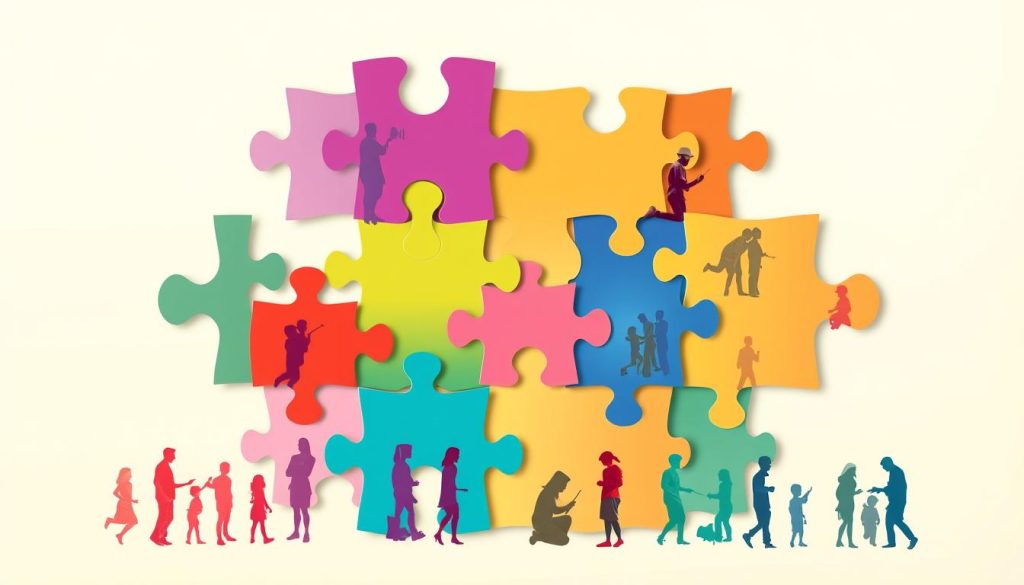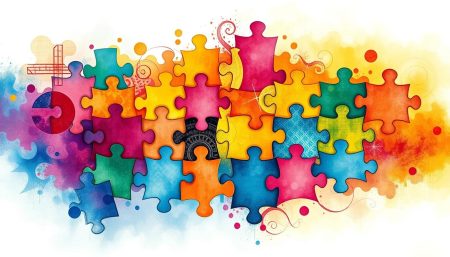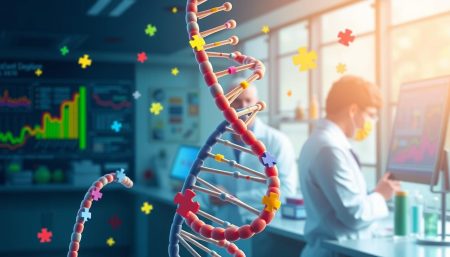Understanding Autism Spectrum Disorder (ASD) means diving into the DSM-V. DSM-V Autism Spectrum Disorder diagnosis is key for support and treatment. The DSM-V from the American Psychiatric Association has new criteria to better understand ASD.
The new criteria reflect our growing knowledge of autism. They help in providing the right support and care. This change makes sure everyone with ASD gets the help they need.
DSM-V shows how far we’ve come in understanding autism. It’s the base for accurate diagnosis and help. Let’s explore the DSM-V Autism Spectrum Disorder and its impact.
What is DSM-V Autism Spectrum Disorder?
The DSM-V autism definition outlines how to diagnose Autism Spectrum Disorder (ASD). It’s based on the fifth edition of the Diagnostic and Statistical Manual of Mental Disorders (DSM-5). This definition sees autism as a spectrum, showing the wide range of symptoms and severities.
The dsm 5 asd diagnosis focuses on two main areas. First, it looks at persistent problems in social communication and interaction. Second, it checks for restricted, repetitive behaviors or interests. This diagnosis helps in planning treatments and educational plans.
The DSM-V criteria for autism changed from the DSM-IV. DSM-5 now has a single diagnosis of ASD. This change aims to make diagnosis more precise and inclusive.
Healthcare providers need to understand these criteria to diagnose and support ASD well. Here’s a closer look at the criteria:
| Criteria | Description | Examples |
|---|---|---|
| Social Communication and Interaction | Deficits in social-emotional reciprocity, nonverbal communicative behaviors, and developing and maintaining relationships. | Lack of eye contact, difficulties understanding social cues, challenges in making friends. |
| Restricted, Repetitive Behaviors | Repetitive motor movements, insistence on sameness, highly restricted interests, hyper- or hypo-reactivity to sensory input. | Repetitive lining up of toys, inflexible adherence to routines, preoccupations with unusual objects. |
This structured approach in the dsm 5 asd criteria ensures a universal standard. It helps maintain a consistent understanding and support for individuals with ASD across different healthcare environments.
Exploring the History of Autism Classification
The history of autism classification shows big changes in how we diagnose and understand autism spectrum disorder (ASD). As doctors and psychologists learned more, the rules in the Diagnostic and Statistical Manual of Mental Disorders (DSM) changed a lot. This is clear when we look at the shift from DSM-IV to DSM-V.
The Evolution of Autism Criteria in DSM
The DSM has played a big role in defining autism spectrum disorder symptoms over the years. When autism was first listed in the DSM-III, it was seen differently than today. Early versions focused on specific types of autism, leaving out many people with related symptoms.
By the time the DSM-IV came out, the view had broadened. This change set the stage for even more updates later on.
Pivotal Changes from DSM-IV to DSM-V
The move to DSM-V brought big changes in how we diagnose and treat autism. The DSM-V autism spectrum disorder now includes a wider range of symptoms. It also focuses more on how severe the symptoms are and what kind of support someone needs.
These updates show how much we’ve learned about autism over the years. They were influenced by lots of research and advocacy.
Here’s a quick look at how the criteria changed:
| Criteria | DSM-IV | DSM-V |
|---|---|---|
| Diagnostic Categories | Autistic Disorder, Asperger’s Disorder, PDD-NOS | Merged into one category: dsm v autism spectrum disorder |
| Symptom Recognition | More rigid criteria, specific to each category | Flexible criteria with spectrum approach |
| Severity Levels | Not systematically defined | Three levels introduced based on support required |
| Comorbid Conditions | Limited recognition and overlap | Increased recognition and diagnostic clarity |
This change reflects a bigger shift in how we see neurological diversity. It helps us understand the unique experiences of those with autism better. These updates lead to more accurate diagnoses and treatments that really help.
Key Diagnostic Criteria for Autism in DSM-V
The DSM-V criteria for autism help doctors diagnose Autism Spectrum Disorder (ASD). They focus on two main areas: social communication and interaction, and repetitive behaviors. Knowing these criteria is key for accurate diagnosis and finding the right help.
Social Communication Challenges
Impairments in social communication and interaction are central to the autism diagnostic criteria. These challenges show up in many ways. For example, people with autism might find it hard to keep up in conversations or share their feelings.
They also struggle with nonverbal cues like body language and facial expressions. The DSM-V criteria explain how these behaviors change over time and differ in different places.
Patterns of Repetitive Behaviors
The DSM 5 ASD criteria focus a lot on repetitive behaviors. These include repetitive movements, a need for sameness, and intense interests. These behaviors can make everyday tasks hard and cause stress when routines are broken.
Sensory sensitivities are also important. They show how certain sounds or sights can affect someone’s behavior and cause them to react strongly.
Here’s a table to show how the DSM-V criteria for autism work in practice:
| Social Communication Challenges | Repetitive Behavioral Patterns |
|---|---|
| Inconsistent eye contact and reduced body language | Repeating words or phrases (echolalia) |
| Difficulty understanding gestures | Compulsions for sameness |
| Struggling to form peer relationships reflecting developmental level | Intense preoccupations with interests |
The DSM-V criteria are the foundation for diagnosing ASD. They look at both the type of behavior and how often it happens. Spotting these signs early can help find the right support for each person.
Understanding the Spectrum: Severity Levels in DSM-V
The dsm 5 autism classification introduced a new way to define autism’s severity levels. These levels help tailor support and interventions to fit each person’s needs. They match the DSM-V criteria for autism.

The DSM-V lists three main severity levels. Each level shows how much support a person needs. These are:
- Requiring support
- Requiring substantial support
- Requiring very substantial support
Understanding these levels helps professionals and families plan the best support for those with autism.
| Severity Level | Symptoms and Behaviors | Required Support |
|---|---|---|
| Requiring Support | Noticeable impairments in social communication; social interactions require clear support and structure. | Support needed for social participation and to manage communication challenges. |
| Requiring Substantial Support | Marked deficits in verbal and nonverbal communication; social impairments apparent even with supports in place. | Consistent support in daily activities; structured support for social interactions. |
| Requiring Very Substantial Support | Severe deficits in communication; preoccupations or fixated behaviors interfere markedly with functioning. | Extensive support required; very structured environment and continuous supervision needed. |
This structured approach in the DSM-V helps us understand autism spectrum disorder symptoms better. It supports planning for the right therapies and educational strategies.
The Importance of Early Diagnosis and Intervention
Understanding the urgency of autism spectrum disorder diagnosis and early intervention is key. It can change the life path for those with DSM-V autism spectrum disorder. Finding out early helps tailor needs and opens doors for better education and behavior help.
Benefits of Early Identification
Early diagnosis leads to better long-term results. It improves social skills, reduces autism symptoms, and boosts school performance. Spotting DSM-V autism spectrum disorder early means starting treatments that enhance communication and social skills.
Intervention Strategies for ASD
- Behavioral therapies like Applied Behavior Analysis (ABA) improve social and learning skills through positive reinforcement.
- Developmental, individual difference, relationship-based approach (DIR/Floortime) focuses on emotional and relational skills.
- TEACCH Autism Program uses the environment’s structure to help with learning and organization.
These strategies show why early and accurate autism spectrum disorder diagnosis is vital. Each method offers a way to tailor help to fit the person’s needs.
DSM-V Criteria for Autism: A Deeper Dive
In this section, we explore the DSM-V criteria for autism. We look at the big changes from earlier versions and how they impact diagnosis today. Knowing these criteria well is key for doctors to diagnose and treat autism spectrum disorder.
Criteria Changes and Their Implications
The move from DSM-IV to DSM-V changed how we diagnose autism. Now, we see autism as a spectrum, not separate subtypes. This change makes diagnosis more accurate by recognizing autism’s many forms in different people.
Comorbid Conditions and Differential Diagnosis
The DSM-V also focuses on comorbid conditions and how to tell autism apart from other disorders. This is important for finding the right treatment for each person. It helps ensure everyone gets the care they need.
Understanding these updates helps us see how autism diagnosis has evolved. Mental health professionals can then tailor care to meet the unique needs of those with autism. This leads to better diagnoses and treatment plans.
Common Misconceptions About DSM-V ASD Diagnosis
When we talk about DSM-V autism spectrum disorder, it’s key to clear up some big misunderstandings. These myths confuse both the public and experts. They come from not fully understanding the topic and old information. We want to help people get a better grasp of the DSM-V autism definition and how it’s used.
Many think the DSM-V made the criteria for ASD too strict, leaving out many people. But, the truth is, the autism diagnostic criteria were made more precise. This change helps ensure diagnoses are accurate and fair, no matter how severe the symptoms are. It focuses on social communication issues and repetitive behaviors, which are key signs of autism.
- ASD is only a childhood disorder: DSM-V shows that autism can be diagnosed at any age, showing it lasts a lifetime.
- High-functioning autism is not included in DSM-V: The term ‘Asperger’s Syndrome’ was merged with ASD to make diagnosis clearer.
Knowing the right facts about DSM-V autism spectrum disorder helps support those affected. It also clears up misconceptions for the public. As research and discussions in healthcare grow, the way we diagnose ASD is getting better.
How DSM-V Autism Spectrum Disorder Affects Families
When a family gets an autism spectrum disorder diagnosis, everything changes. This diagnosis affects how the individual lives their daily life. It also changes how the family interacts with each other.

Family roles and relationships start to change to meet new needs. It’s important for families to build strong support networks. These networks offer emotional and practical help.
Navigating the Emotional Landscape
Getting a diagnosis can bring up many feelings in family members. They might feel confused, worried, or relieved. Research shows that counseling and support groups help families stay emotionally strong.
Family Dynamics and Support Systems
Family life can change a lot. Parents and siblings might need to learn new ways to communicate. They also need to adjust their expectations. Local support groups are key, providing resources and a sense of community.
| Aspect | Impact | Support Offered |
|---|---|---|
| Daily Routines | Structural Changes | Therapy and schedules |
| Communication | Increased challenges | Communication tools and support groups |
| Emotional Health | Stress, anxiety | Counseling, peer support |
| Social Experience | Potential Isolation | Community activities, inclusive events |
By understanding the DSM-V criteria for autism, families can do more than just survive. They can thrive in a supportive environment. This environment is built on the diagnosis and strong family support.
Integrating DSM-V ASD into School and Education Plans
Understanding DSM-V autism spectrum disorder is changing fast. Schools must keep up and create supportive learning spaces. They use Individualized Education Programs (IEPs) and strong inclusion strategies to help students with ASD fit in better.
Individualized Education Programs (IEPs)
IEPs are special plans for students with DSM-V autism spectrum disorder. Teachers, therapists, and parents work together to make these plans. They make sure students get the right support and resources they need.
Inclusion Strategies for Students with ASD
Inclusion strategies help create a welcoming classroom for students with ASD. These strategies include changing how teachers teach, using special tools, and training staff. This way, all students can learn and grow together.
| Strategy | Description | Impact |
|---|---|---|
| Peer-mediated instruction | Training selected students to assist peers with ASD | Enhances social interaction and participation in classroom activities |
| Visual Supports | Use of images, symbols, or written words to communicate | Helps students with ASD understand and follow classroom routines |
| Behavioral Interventions | Techniques based on behavior analysis for positive reinforcement | Improves behavior and learning outcomes |
Addressing the Needs of Adults with DSM-V Autism Spectrum Disorder
Transitioning from childhood to adulthood is tough for those with DSM-V autism spectrum disorder. As they grow older, they need adult services tailored to their needs. This part looks at what support adults with autism require.
Adults with autism face different challenges, like finding jobs and managing relationships. They also need healthcare that fits their needs. Groups like Autism Speaks help by providing resources and support.
- Workplace Accommodations: Important for adults with autism to do well at work.
- Lifelong Learning: Special programs help with everyday life challenges.
- Healthcare Access: Medical and psychological support that changes with the disorder.
Diagnosing autism in adults is different. They might need a new evaluation to make sure they get the right help.
| Aspect | Child Services | Adult Services |
|---|---|---|
| Focus | Basic Education and Early Therapy | Employment and Independent Living Skills |
| Support Type | Parent-Centered Guidance | Individual-Centered Planning |
| Goal | Developmental Progress | Sustained Autonomy |
The shift from childhood to adulthood is big. It moves from focusing on development to helping adults be independent. Understanding and meeting these needs is key for a good life for adults with autism.
The Role of Healthcare Providers in Managing DSM-V Autism Spectrum Disorder
Healthcare providers are key in handling DSM-V autism spectrum disorder. They use new therapeutic interventions and interdisciplinary treatment plans. This is important for giving full care and better lives to those with ASD.
Interdisciplinary Approaches to Treatment
Teams of different healthcare experts are at the heart of good ASD care. These teams include psychologists, pediatricians, speech therapists, and occupational therapists. They work together to make treatment plans that fit each person’s needs. This way, they cover all parts of the disorder, helping people with autism grow and develop better.
Advancements in Therapeutic Interventions
New treatments for DSM-V autism spectrum disorder have been developed. These include behavioral therapies, medicines, and special therapies like music or art. These have been shown to help with social skills and reduce symptoms of ASD.
| Intervention Type | Benefits | Typical Age Group |
|---|---|---|
| Behavioral Therapies | Improves communication skills, enhances social interaction | Children |
| Pharmacological Treatments | Manages co-occurring symptoms like irritability and aggression | Adolescents |
| Complementary Therapies | Increases self-expression and emotional regulation | All Ages |
In conclusion, teamwork among healthcare experts and new treatments are key. They help deal with the challenges of DSM-V autism spectrum disorder well.
DSM-V Autism Spectrum Disorder in Different Cultures
Looking into the DSM-V criteria for autism shows us how this diagnosis is seen and handled in various cultures. It’s key to be culturally sensitive when diagnosing, as cultural views and norms shape how we see and treat autism.
The use of the DSM-V criteria for autism changes from culture to culture. This affects not just how we diagnose but also how we treat autism. It shows the need for healthcare workers to adjust and grow their methods to fit different cultural needs.
Cultural Sensitivity in Diagnosis
When using DSM-V for diagnosis, we must add cultural sensitivity. This helps us see and deal with autism in different ways across cultures. Healthcare workers need to understand cultural views on social norms and communication. This makes diagnoses more accurate and respectful, improving the bond between healthcare providers and families.
Global Perspectives on Autism Spectrum Disorder
Looking at autism from a global view helps us see its effects on families and communities around the world. Research shows that awareness and action on autism vary greatly. Some places are more aware and have better strategies than others. Here, global health groups are key in sharing knowledge and helping countries learn from each other.
| Country | Awareness Level | Common Interventions |
|---|---|---|
| USA | High | Behavioral Therapies, Educational Programs |
| Brazil | Medium | Community Support, Limited Medical Intervention |
| India | Low | Non-profit Organizations, Awareness Campaigns |
Research Directions and Future Updates to DSM-V ASD
The world of DSM-V autism spectrum disorder research is always changing. New technology and a better understanding of the brain are leading the way. These changes could bring big updates to how we diagnose ASD.
Genetic markers and brain functions are key areas of study. They hold the key to improving how we diagnose and treat ASD.
Emerging Trends in Autism Research
New tools like neuroimaging and genetic testing are leading the research. They aim to understand what causes DSM-V autism spectrum disorder. These tools could help find specific signs of ASD, leading to earlier and more accurate diagnoses.
Anticipated Updates to the DSM and Their Impact
Studies and expert opinions suggest big changes are coming to the DSM. There’s a push for a more detailed classification of autism. This would better match the wide range of symptoms and abilities in people with ASD.
These updates could make treatment more effective. They would allow for more personalized care for each individual.
| Research Area | Impact on DSM-V ASD | Potential DSM Updates |
|---|---|---|
| Genetic Markers | Improved Diagnostic Accuracy | Introduction of Genetic Screening |
| Neuroimaging Techniques | Enhanced Understanding of ASD Brain Function | Refined Neurological Criteria |
| Behavioral Studies | Better Symptom Classification | Expanded Behavioral Spectrum |
Living with DSM-V Autism Spectrum Disorder: Personal Stories & Insights
The journey of living with DSM-V autism spectrum disorder (ASD) is unique for each person. Through personal stories, we see the daily life and deep effects of ASD. These stories show both the big wins and tough times of living with ASD.
Parents share their journeys in books, showing the ups and downs of raising a child with ASD. Their stories highlight the need for support, whether from family or services. Adults with ASD share their own ways of dealing with the world, showing the diversity of ASD.
These stories also affect communities, changing how people see DSM-V autism spectrum disorder. They call for more understanding and inclusion. While progress has been made, these stories remind us of the ongoing need for acceptance and support.
FAQ
Q: What Is DSM-V Autism Spectrum Disorder?
A: DSM-V Autism Spectrum Disorder is a set of conditions outlined in the fifth edition of the Diagnostic and Statistical Manual of Mental Disorders (DSM-5). It includes symptoms that affect social interaction, communication, interests, and behavior.
Q: How Is Autism Spectrum Disorder Diagnosed According To DSM-V Criteria?
A: To diagnose Autism Spectrum Disorder (ASD) under DSM-V, a detailed evaluation is needed. This includes looking at social communication and interaction, and observing repetitive behaviors. A psychologist or psychiatrist will assess if an individual meets the DSM-5 criteria.
Q: What Are the Key Diagnostic Criteria for Autism in DSM-V?
A: The main criteria for autism in DSM-V are persistent social communication and interaction deficits. There are also restricted, repetitive behaviors and interests. Symptoms must be present from early childhood and impact daily life.
Q: How Have the Autism Criteria Evolved from DSM-IV to DSM-V?
A: The autism criteria have changed a lot from DSM-IV to DSM-V. The old categories like autistic disorder and Asperger’s syndrome are now under one term, “Autism Spectrum Disorder”. DSM-V also focuses more on social communication and simplifies the repetitive behavior criteria.
Q: Why Is Early Diagnosis and Intervention for ASD Important?
A: Early diagnosis and intervention are key for ASD. They help improve language, social skills, and cognitive abilities. Early help also supports families in understanding and managing the condition.
Q: How Does DSM-V Classify the Severity of Autism Spectrum Disorder?
A: DSM-V classifies ASD severity into three levels. Level 1 needs minimal support, Level 2 needs substantial support, and Level 3 needs very substantial support. Each level shows the difficulty in social communication, interaction, and repetitive behaviors.
Q: What Are Some Common Misconceptions About DSM-V ASD Diagnosis?
A: Some think DSM-V criteria are less inclusive, leading to fewer diagnoses. Others believe all individuals with ASD are the same. DSM-V shows the spectrum’s diversity. It’s also wrong to think a diagnosis means limited capabilities; people with ASD have many strengths.
Q: How Does a DSM-V ASD Diagnosis Influence Family Dynamics and Support Systems?
A: A DSM-V ASD diagnosis can change family dynamics, bringing challenges and opportunities. Families grow stronger as they face the condition together. Support systems are key, providing emotional and informational help, and guiding families in finding effective interventions.
Q: In What Ways Can DSM-V ASD Be Incorporated into School and Education Plans?
A: DSM-V ASD can be included in school plans through Individualized Education Programs (IEPs). These plans are tailored to meet a student’s specific needs. Inclusion strategies provide the right supports, allowing students with ASD to learn with their peers in general education classes.
Q: How Do Healthcare Providers Manage DSM-V Autism Spectrum Disorder?
A: Healthcare providers manage DSM-V ASD with an interdisciplinary approach. This may include behavioral therapies, medications, and communication training. They work together to offer care tailored to each individual’s needs.
Q: Why Is Cultural Sensitivity Important in Diagnosing DSM-V Autism Spectrum Disorder?
A: Cultural sensitivity is vital in diagnosing DSM-V ASD. Cultural norms can affect how symptoms are expressed and understood. Understanding these perspectives ensures accurate diagnosis and respectful treatment, considering the diversity of experiences and backgrounds.
Q: What Are the Anticipated Updates to DSM-V and Their Possible Impact?
A: Future updates to DSM-V might include refined criteria based on new research. They could also better recognize symptoms across different ages and include genetic and neurobiological findings. These changes could improve diagnosis, treatment, and support for individuals with ASD and their caregivers.
Q: What Insights Can Personal Stories Provide About Living with DSM-V Autism Spectrum Disorder?
A: Personal stories offer deep insights into living with DSM-V ASD. They show the daily challenges and triumphs, highlighting the importance of support and understanding. These stories inspire and educate others about the diversity within the autism spectrum.


















